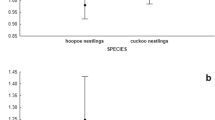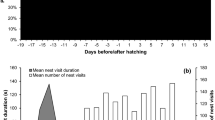Summary
Nest defence is a frequent and widespread parental behaviour which enhances brood survival. We have found that in a Spanish Magpie population which is heavily parasitized by the brood parasitic Great Spotted Cuckoo, Magpies defend (1) unparasitized more frequently than parasitized nests, and (2) at the end of the nestling period more frequently than in other stages of the breeding cycle. Great Spotted Cuckoos are brood parasites, which means that their eggs are incubated and their nestlings are raised by members of a host species. Brood parasites are not thought to take care of their own offspring. However, we have found that Great Spotted Cuckoos sometimes scolded us on our regular visits to parasitized magpie nests (but never on those to unparasitized nests). Frequency of nest defence by cuckoos differed significantly among years, being significantly higher at the beginning of the study. Although sporadic observations of adult brood parasites feeding juveniles have been recorded, nest defence has not previously been suggested for any brood parasite.
Zusammenfassung
Nestverteidigung ist ein häufiges und weit verbreitetes elterliches Verhalten zur Erhöhung des Bruterfolges. In einer spanischen Elsterpopulation, die sehr intensiv vom Häherkuckuck parasitiert ist, wurden unparasitierte Nester häufiger verteidigt als parasitierte, und zum Ende der Nestlingsperiode wurden Nestern häufiger verteidigt als zu früheren Phasen des Brutzyklus. Häherkuckucke sind Brutparasiten, deren Eier von den Wirtseltern bebrütet und die Nestlinge von ihnen aufgezogen werden. Solche Brutparasiten kümmern sich im allgemeinen nicht selbst um ihre Nachkommen. Manchmal jedoch haßten Häherkuckuck auf uns, wenn wir parasitierte Nester der Elster kontrollierten, während an unparasitierten Nestern ein solches Hassen niemals erfolgte. Die Häufigkeit dieser Nestverteidugung der Kuckucke variierte zwischen Jahren und war signifikant häufiger zu Beginn unserer Untersuchung. Zwar wurde gelegentlich schon Füttern der Jungvögel durch elterliche Brutparasiten beobachtet, die hier festgestellte Nestverteidung ist bisher aber von keinem Brutparasiten beschrieben.
Similar content being viewed by others
References
Andersson, M., Wiklund, C.G. & Rundgren, H. (1980): Parental defence of offspring: a model and an example. Anim. Behav. 28: 536–542.
Bazin, R. & Sealy, S.G. (1993): Experiments on the responses of a rejector species to threats of predation and cowbird parasitism. Ethology 94: 326–338.
Brooker, M.G. & Brooker, L.C. (1989): Cuckoo hosts in Australia. Aust. Zool. Rev. 2: 1–67.
Buitron, D. (1983): Variability in the response of black-billed magpies to natural predators. Behaviour 78: 209–236.
Clutton-Brock, T.H. (1991): The evolution of parental care. Princeton University Press, Princeton.
Cramp, S. & Simmons, K.E.L. (Ed., 1985): The Birds of the Western Palaearctic. Vol IV. Oxford.
Erpino, M. J. (1968): Nest-related activities of black-billed magpies. Condor 70: 154–165.
Friedmann, H. (1968): The evolutionary history of the genusChrysococcyx. Washington.
Gill, S.A., Grieef, P.M., Staib, L.M. & Sealy, S.G. (1977): Does nest defence deter or facilitate cowbird parasitism? A test of the nesting-cue hypothesis. Ethology 103: 56–71.
Greig-Smith, P.W. (1980): Parental investment in nest defence by stonechats (Saxicola torcuata). Anim. Behav. 28: 604–619.
Hurlbert, S.H. (1984): Pseudoreplication and the design of ecological field experiments. Ecol. Monograph. 54: 187–211.
Montgomerie, R.D. & Weatherhead, P.J. (1988): Risks and rewards of nest defence by parent birds. Q. Rev. Biol. 63: 167–187.
Neudorf, D.L. & Sealy, S.G. (1992): Reactions of four passerine species to threats of predation and cowbird parasitism: enemy recognition or generalized responses? Behaviour 123: 84–105.
Onnebrink, H. & Curio, E. (1991): Brood defence and age of young: a test of the vulnerability hypothesis. Behav. Ecol. Sociobiol. 29: 61–68.
Payne, R.B. (1974): The evolution of clutch size and reproductive rates in parasitic cuckoos. Evolution 28: 169–181.
Payne, R.B. (1977): The ecology of brood parasitism. Annu. Rev. Ecol. Syst. 8: 1–28.
Redondo, T. & Carranza, J. (1989): Offspring reproductive value and nest defence in the magpie (Pica pica). Behav. Ecol. Sociobiol. 25: 369–378.
Robertson, R.J. & Norman, R.F. (1976): Behavioral defenses to brood parasitism by potential hosts of the brown-headed cowbird. Condor 78: 166–173.
Röell, A. & Bossema, I. (1982): A comparison of nest defence by jackdaws, rooks, magpies and crows. Behav. Ecol. Sociobiol. 11: 1–6.
Rothstein, S.I. (1990): A model system for coevolution: avian brood parasitism. Annu. Rev. Ecol. Syst. 21: 481–508.
Skutch, A.F. (1976): Parents birds and their young. Austin.
Sokal, R.R. & Rohlf, F.J. (1981): Biometry. New York.
Soler, M. (1990): Relationships between the great spotted cuckooClamator glandarius and its corvid hosts in a recently colonized area. Ornis Scand. 21: 212–223.
Soler, M., Palomino, J.J., Martinez, J.G. & Soler, J.J. (1994a): Activity, survival, independence and migration of fledgling Great Spotted Cuckoos. Condor 96: 802–805.
Soler, M., Soler, J.J., Martinez, J.G. & Møller, A.P. (1994b): Micro-evolutionary change in host response to a brood parasite. Behav. Ecol. Sociobiol. 35: 295–301.
Soler, M., Palomino, J.J., Martinez, J.G. & Soler, J.J. (1995a): Communal parental care by monogamous magpie hosts of fledgling great spotted cuckoos. Condor 96: 802–805.
Soler, M., Soler, J.J., Martinez, J.G. & Møller, A.P. (1995b): Magpie host manipulation by Great Spotted Cuckoos: Evidence for an avian mafia? Evolution 49: 770–775.
Soler, M., Soler, J.J., Martinez, J.G., Pérez-Contreras, T. & Møller, A.P. (1998): Micro-evolutionary change and population dynamics of a brood parasite and its primary host: the intermittent arms race hypothesis. Oecologia (in press).
Trivers, R.L. (1972): Parental investment and sexual selection, p. 136–179. In: Campbell, B.G. (Ed.): Sexual selection and the descent of man 1871–1971. Chicago.
Zahavi, A. (1979): Parasitism and nest predation in parasitic cuckoos. Am. Nat. 113: 157–159.
Author information
Authors and Affiliations
Corresponding author
Rights and permissions
About this article
Cite this article
Soler, M., Martínez, J.G. & Soler, J.J. Nest defence by Magpies(Pica pica) and the brood parasitic Great Spotted Cuckoos(Clamator glandarius) in parasitized and unparasitized nests. J Ornithol 140, 199–205 (1999). https://doi.org/10.1007/BF01653599
Accepted:
Published:
Issue Date:
DOI: https://doi.org/10.1007/BF01653599




